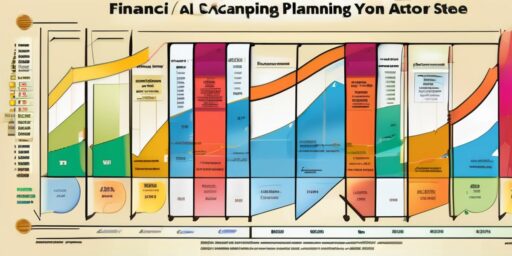Navigating the complexities of personal finance can be daunting, but with the right tools and knowledge, anyone can chart a course to financial stability and growth. ‘Visualizing Your Fiscal Path: A Redditor’s Guide to the Personal Finance Flowchart’ is designed to provide readers with a clear and concise roadmap to managing their finances. From budgeting basics to investment strategies, this guide covers essential topics to help you understand and improve your financial situation.
Key Takeaways
- Personal finance is a critical skill that involves budgeting, saving, investing, and planning for financial milestones.
- The 50/30/20 rule is a simple yet effective budgeting guideline that can help manage spending and saving.
- Understanding the difference between good debt and bad debt is essential for effective debt management and financial health.
- Investing in the stock market and other venues is a powerful way to grow wealth over time, but requires informed decision-making.
- Regularly using financial tools and resources, like calculators and quizzes, can provide insights and keep you on track with your financial goals.
Understanding the Basics of Personal Finance


What is Personal Finance?
Personal finance encompasses all aspects of managing your money, from budgeting and saving to investing and planning for retirement. It’s the art of making your money work for you, ensuring that you can meet your current needs while also securing your financial future. Personal finance is about taking control of your financial destiny.
- Budgeting: Tracking income and expenses
- Saving: Setting aside money for future needs
- Investing: Growing wealth over time
- Retirement Planning: Preparing for financial security in later life
Personal finance is not just about numbers; it’s about setting goals, making informed decisions, and understanding the impact of those decisions on your overall financial well-being. It’s a continuous process that evolves with your life stages and financial goals.
The 50/30/20 Rule for Budgeting
The 50/30/20 rule is a straightforward framework designed to simplify the allocation of your after-tax income. It suggests that 50% of your income should go towards necessities, such as rent and groceries, 30% towards discretionary spending, like dining out and entertainment, and the remaining 20% should be saved or used to pay off debt.
By adhering to this rule, you can create a balanced budget that covers essential expenses, allows for personal enjoyment, and promotes financial stability.
Understanding and applying the 50/30/20 rule can be the first step towards achieving personal finance success. It’s a method that helps to prevent taking on more debt than one can afford, and it encourages a healthier financial life.
Here’s a quick breakdown of how to apply the 50/30/20 rule to your monthly income:
- 50% Needs: Housing, utilities, groceries, transportation, insurance
- 30% Wants: Travel, hobbies, dining out, shopping
- 20% Savings/Debt: Emergency fund, retirement savings, credit card payments
Financial Planning Checklist
Creating a financial planning checklist is a proactive step towards achieving your financial goals. Regularly reviewing and updating your financial plan is crucial for staying on track. Here’s a simple checklist to guide you through the essentials:
- Assess your current financial situation.
- Set short-term and long-term financial goals.
- Create a budget that aligns with your goals.
- Build an emergency fund to cover unexpected expenses.
- Pay down high-interest debt as a priority.
- Review your insurance coverage to ensure adequate protection.
- Plan for retirement by contributing to a pension or retirement account.
- Consider consulting a financial advisor for personalized advice.
Remember, personal financial planning is not a one-time task but an ongoing process that adapts to your changing life circumstances. Make it a habit to revisit your financial plan at least annually or whenever there’s a significant change in your life.
Financial Life Stages
Understanding your financial life stages is crucial for planning and achieving your monetary goals. Each stage of life presents unique financial challenges and opportunities. From starting your first job to planning for retirement, your financial strategies should evolve to fit your current circumstances.
It’s important to recognize that financial planning is not a one-size-fits-all process. Tailoring your approach to each life stage can lead to better financial health and peace of mind.
Here’s a quick overview of the typical financial life stages:
- Early Career: Building a foundation, managing student debt, and starting to save.
- Mid-Career: Advancing in your career, buying a home, and growing your investments.
- Pre-Retirement: Maximizing retirement savings, paying off debt, and planning for healthcare costs.
- Retirement: Managing withdrawals, estate planning, and enjoying the fruits of your labor.
Each stage requires a different focus and set of actions. By understanding and planning for these stages, you can create a financial roadmap that grows and adapts with you over time.
Creating a Solid Financial Foundation


How to Create a Budget
Creating a budget is the cornerstone of sound financial management. Calculate your monthly income first, as it sets the stage for how much you can allocate towards different expenses. Next, choose a budgeting method that suits your lifestyle and financial goals. The 50/30/20 rule is a simple framework that can help you get started: 50% of your income goes to needs, 30% to wants, and 20% to savings and debt repayment.
To monitor your progress effectively, regularly review your spending and adjust your budget as needed. This ensures you stay on track with your financial objectives.
Here’s a basic outline to help you visualize the budgeting process:
- Identify your total monthly income.
- Categorize your expenses into ‘needs’, ‘wants’, and ‘savings/debt’.
- Allocate funds according to your chosen budgeting method.
- Track your expenses and compare them to your budget.
- Adjust your budget as necessary to meet your financial goals.
Managing Debt: Good Debt vs. Bad Debt
Understanding the distinction between good debt and bad debt is crucial for effective debt management. Good debt is an investment that will grow in value or generate long-term income, such as student loans for education or a mortgage for a home. On the other hand, bad debt typically involves borrowing for depreciating assets or consumables, like high-interest credit card debt for luxury items.
When considering taking on debt, it’s important to evaluate the potential return on investment and the impact it will have on your financial future.
Here’s a simple way to categorize your debts:
- Good Debt: Education, Home, Business
- Bad Debt: Credit cards, High-interest personal loans
By prioritizing the repayment of bad debts and leveraging good debts wisely, you can navigate your financial journey more effectively. Remember, the goal is to use debt as a tool to build wealth, not as a burden that hinders your financial progress.
Creating a Debt Management Plan
Creating a debt management plan is a crucial step towards financial freedom. Take inventory of your finances to understand your current situation, including income, expenses, debts, and assets. This will serve as the foundation for your plan.
Rebuild your emergency fund if needed, aiming for 3-6 months of expenses. Set up automatic transfers to make the process effortless.
Once you have a clear picture, prioritize your debts. Start with those carrying the highest interest rates, often credit cards or personal loans. A structured approach, such as the debt avalanche or snowball method, can be effective. Here’s a simple breakdown of these strategies:
- Debt Avalanche: Pay off debts from highest to lowest interest rate.
- Debt Snowball: Pay off debts from smallest to largest balance.
Remember, if you’re struggling to manage your debts, seeking help from a nonprofit credit counseling agency can provide valuable guidance and support.
Budgeting for Couples
When it comes to managing finances as a couple, communication is key. Planning weekly meetings to discuss financial plans, expenditures, and any deviations from the budget can help both partners stay aligned and accountable. It’s important to establish a clear and fair system for handling shared expenses and savings goals.
Creating a joint budget can be a challenging but essential step for couples. Here’s a simple list to get started:
- Determine your combined monthly income
- List all shared and individual expenses
- Agree on personal spending limits
- Decide on short-term and long-term savings goals
- Review and adjust the budget regularly
Remember, the goal of budgeting as a couple is not just to track where money is going, but to build a financial future together. It’s about finding a balance that works for both partners and supports your collective aspirations.
Strategies for Growing Your Wealth


Save, Invest, Grow Your Wealth!
Taking control of your financial future involves a clear understanding of where you stand today and a well-defined strategy for where you want to be tomorrow. Budgeting, saving, and investing are the pillars of a solid financial plan that aims to grow your wealth over time.
To save money effectively, consider these smart strategies:
- Understanding your finances to identify potential savings.
- Implementing effective budgeting strategies to manage your cash flow.
- Reducing everyday expenses to increase your savings rate.
Remember, the journey to financial independence is a marathon, not a sprint. It’s about making consistent, informed decisions that contribute to your long-term success.
For goals like retirement or education funding, a long-term investment perspective is crucial. While investments do not guarantee growth and may lose value, a diversified approach can help manage risks. Consult a financial professional to tailor a strategy that fits your unique situation.
Investment Strategies for 2023
As we navigate through 2023, it’s crucial to revisit and refine our investment strategies to align with current market conditions and personal financial goals. The investment landscape is constantly evolving, and what worked in the past may not be the best approach for the future.
For those looking to build a robust portfolio, considering a mix of long-term investments is essential. Exchange Traded Funds (ETFs), Dividend Stocks, Short-term Bonds, Real Estate, and Alternative investments are among the top contenders for a diversified investment strategy.
While excitement and the potential for quick profits can be tempting, it’s important to assess whether such strategies are conducive to your long-term objectives. Active trading and chasing meme stocks or digital assets may offer immediate gratification, but they also carry significant risks. A balanced approach that includes consistent saving and patience often paves the way to financial success.
Here are the 5 Best Long Term Investments to consider adding to your portfolio in 2023:
- Exchange Traded Funds (ETFs)
- Dividend Stocks
- Short-term Bonds
- Real Estate
- Alternative investments
Remember, investments are not guaranteed to grow and may lose value over time. Consulting with a financial professional can provide personalized advice tailored to your individual needs and goals.
Building Wealth through the Stock Market
The stock market has long been a cornerstone for those looking to build wealth over time. While it comes with its share of risks, understanding the market’s dynamics can lead to significant financial gains. For many, the key to success lies in a diversified portfolio and a long-term investment strategy.
Investing in the stock market isn’t just about picking stocks and hoping for the best. It involves a strategic approach that includes research, patience, and sometimes, a bit of fortitude. Here are a few strategies that have stood the test of time:
- Pick an investment account that suits your needs and goals.
- Consider index funds for a diversified approach.
- Embrace the "Buy and hold" strategy to weather market volatility.
- Look into dividend-paying stocks for a potential steady income stream.
Remember, the goal isn’t to outsmart the market, but to be positioned in a way that you can benefit from its overall growth over time.
Before diving into the stock market, it’s crucial to have a clear understanding of your financial goals and risk tolerance. Consulting with a financial advisor can provide personalized guidance tailored to your unique situation.
Pay Off Debt or Invest Your Money?
Deciding whether to pay off debt or invest your money is a crucial financial decision. The right choice depends on your personal financial situation, goals, and the interest rates involved.
Keep in mind that you should consider the pros and cons of the cost of carrying debt versus the interest you’ll earn from saving before making a decision.
Here’s a simple checklist to help you decide:
- Take inventory of your finances, including income, expenses, debts, and assets.
- Compare the interest rates on your debts with the potential returns from investments.
- If you have high-interest debt, prioritize paying it off.
- For lower-interest debts, consider investing if the expected returns are higher.
- Always maintain an emergency fund of 3-6 months of expenses.
Remember, there’s no one-size-fits-all answer. It’s about balancing the risk and potential reward, and sometimes, a combination of both paying off debt and investing can be the best strategy.
Planning for Major Financial Milestones


How to Prepare for Tax Season 2023
As the tax season approaches, it’s crucial to be well-prepared to ensure a smooth filing process. Gather all necessary tax paperwork and records for accuracy to avoid missing out on any potential deductions or credits. This includes W-2s, 1099s, receipts for deductible expenses, and records of any estimated tax payments made during the year.
Remember to report all types of income on your tax return, whether it’s from traditional employment, freelance work, investments, or even small side jobs. Failing to report income can lead to penalties and interest on any unpaid taxes.
Filing your taxes can be a complex process, but taking it step by step can help you manage it more effectively. Start by taking inventory of your financial situation, including your income, expenses, and debts. This will give you a clearer picture of what to expect and how to plan for any tax liabilities or refunds.
Lastly, consider using tax software or consulting with a tax professional if you’re unsure about any aspect of your return. They can provide valuable guidance and help you maximize your refund or minimize your tax liability.
Guide to Personal Finance in Your 20s
Navigating your 20s can be a thrilling yet daunting journey, especially when it comes to managing your finances. Creating a solid financial foundation during this time is crucial for long-term success. Start by setting clear financial goals, whether it’s paying off student loans, saving for a down payment on a home, or simply building an emergency fund.
Establishing a budget is your roadmap to financial freedom. It helps you prioritize your spending and track your progress towards your goals.
Consider the following steps to take control of your personal finance in your 20s:
- Educate yourself on financial basics and tools.
- Build a budget that aligns with your income and goals.
- Focus on paying off high-interest debts as soon as possible.
- Start an emergency fund to cover at least three to six months of living expenses.
- Explore investment options to grow your wealth over time.
Remember, the habits you form now will pave the way for your financial future. It’s about making informed decisions and adjusting your plan as your life and the economy evolve.
How You Could Pay Off Student Loans Before 30
Paying off student loans before hitting the big 3-0 can seem like a daunting task, but with the right strategy, it’s an achievable goal. Start by evaluating your current financial landscape, including your income, monthly expenses, and total debt. This will give you a clear picture of where you stand.
One effective method is to make biweekly payments, which can help you pay off your loans faster without the need for large lump-sum payments. Here’s a simple breakdown of how this works:
- Biweekly Payment Plan: Instead of one monthly payment, you make half the payment every two weeks. This results in 26 half-payments or 13 full payments per year, effectively making one extra payment annually.
By consistently making biweekly payments, you’ll reduce the principal balance more quickly, leading to less accrued interest over the life of the loan.
Remember, paying off student loans early can free up financial resources for other goals, such as saving for a home or investing for retirement. It’s important to weigh the benefits of early loan payoff against other financial priorities you may have.
How Much Does It Cost to Raise a Child?
Raising a child is one of the most significant financial commitments an individual or couple can make. The cost of raising a child to the age of 18 is estimated to be in the hundreds of thousands of dollars, varying greatly depending on location, lifestyle, and unexpected expenses.
While the joy of parenting is priceless, the financial aspect can be daunting. It’s crucial to plan ahead and consider the long-term costs involved in raising a child.
Here’s a breakdown of some of the key expenses:
- Housing: The largest portion of the cost, including rent or mortgage payments, utilities, and maintenance.
- Childcare and education: From daycare to college tuition, these expenses can accumulate quickly.
- Food: Regular grocery bills plus the additional cost of feeding a growing child.
- Healthcare: Insurance premiums, out-of-pocket expenses, and other medical costs.
- Clothing, entertainment, and miscellaneous: These can vary widely but are important to consider.
Understanding these costs can help parents prepare financially for the journey ahead. It’s advisable to start saving early, explore cost-saving strategies, and seek financial advice if needed.
Utilizing Financial Tools and Resources


Retirement Withdrawal Calculator
A Retirement Withdrawal Calculator is an essential tool for anyone looking to understand how long their retirement savings might last. This calculator helps you project the sustainability of your retirement funds by taking into account your current savings, expected rate of return, and annual withdrawal amounts.
To estimate how long your money will last in retirement, weigh annual expenses against total savings plus investment returns over time.
Here’s a simple breakdown of the factors you should consider when using a retirement withdrawal calculator:
- Current retirement savings: The total amount you have saved up to this point.
- Expected rate of return: The annual percentage you expect your investments to grow.
- Annual withdrawal rate: The percentage of your savings you plan to withdraw each year.
- Inflation rate: The expected increase in the cost of living over time.
By inputting these variables, you can get a clearer picture of your financial future and make informed decisions about your retirement strategy.
College Savings Calculator
Saving for college is a significant financial goal for many families, and understanding how much to save is crucial. Use our college savings calculator to determine how much you should be saving each month. This tool takes into account various factors such as current savings, college costs, and investment returns to provide a personalized savings plan.
To get started, you’ll need to input some basic information:
- Current savings for college
- Estimated annual college costs
- Expected rate of return on investments
- Number of years until college
By inputting this data, the calculator can project future college costs and recommend a monthly savings amount. It’s important to review and adjust these figures regularly to stay on track with your college savings goals.
Remember, the earlier you start saving, the more you can benefit from compound interest. Even small contributions can grow over time, making a significant impact on your college fund.
Business Valuation Calculator
Determining the value of a business is a complex process that involves understanding various financial metrics and market conditions. A Business Valuation Calculator simplifies this task by providing a structured approach to estimate the worth of your business. It’s an essential tool for business owners planning to sell, seeking investment, or simply keeping track of their company’s financial health.
To effectively use a Business Valuation Calculator, consider the following steps:
- Gather financial statements and business records.
- Input key figures such as revenue, expenses, and growth projections.
- Adjust for market conditions and industry multipliers.
- Review the calculated valuation and consider any non-quantifiable factors.
Remember, while a calculator can give you a numerical estimate, it’s important to also consider the qualitative aspects of your business that might affect its true value.
For those looking to track personal wealth alongside their business’s value, an accurate net worth calculator can be a valuable companion. It allows you to effortlessly track and manage your wealth, ensuring a brighter financial future.
Financial Style Quiz
Understanding your financial personality is crucial in shaping your approach to managing money. Are you an Ostrich, a Jitterbug, or a Spendy Wendy when it comes to your finances? Taking a financial style quiz can provide insights into your spending habits and saving tendencies.
By identifying your financial style, you can tailor your budgeting and investment strategies to better suit your personality and goals.
The quiz categorizes participants based on their responses to a series of questions about their financial behaviors. Here’s a brief overview of what you might discover about yourself:
- Ostrich: You might avoid looking at your finances altogether.
- Jitterbug: You could be someone who is nervous about financial decisions.
- Spendy Wendy: Perhaps you’re known for impulsive spending.
Once you know your financial style, you can explore resources and tools that align with your personality. This could include budgeting apps for the Ostrich to keep finances in check, investment courses for the Jitterbug to build confidence, or spending trackers for Spendy Wendy to monitor cash flow.
Conclusion
Navigating the complexities of personal finance can be daunting, but with the right tools and understanding, anyone can chart a course towards financial stability and growth. The Personal Finance Flowchart is an invaluable guide, providing a visual roadmap to managing your money effectively. By following the steps outlined in this Redditor’s guide, from budgeting with the 50/30/20 rule to tackling debt and investing wisely, you can gain control over your finances and work towards your long-term goals. Remember, the journey to financial freedom is ongoing, and it’s essential to review and adjust your plan regularly. Whether you’re preparing for tax season, planning for your 20s, or setting sights on retirement, the principles discussed here can help you save, invest, and grow your wealth. Take the first step today, and empower yourself with the knowledge to make informed financial decisions for a prosperous future.
Frequently Asked Questions
What is the 50/30/20 rule for budgeting?
The 50/30/20 rule is a simple budgeting guideline that suggests allocating 50% of your income to necessities, 30% to wants, and 20% to savings and debt repayment.
How can I create a solid financial foundation?
To create a solid financial foundation, start by creating a budget, managing and prioritizing debts, establishing an emergency fund, and setting financial goals.
What are some effective investment strategies for 2023?
Effective investment strategies for 2023 include diversifying your portfolio, considering low-cost index funds, staying informed about market trends, and aligning investments with your financial goals.
How should I prepare for tax season 2023?
Prepare for tax season 2023 by organizing all relevant financial documents, understanding tax deductions and credits you’re eligible for, and possibly consulting a tax professional.
What financial tools can help me with retirement planning?
Financial tools like retirement withdrawal calculators, pension estimators, and retirement planning software can help you plan your retirement finances more effectively.
Is it better to pay off debt or invest my money?
The decision to pay off debt or invest depends on the interest rates, your financial situation, and your risk tolerance. Generally, prioritize high-interest debt before investing.





